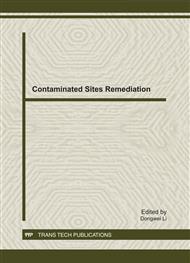[1]
S. Alker, V. Joy, P. Roberts, N. Smith, The definition of brownfield, J. Environ. Planning Manage. 43 (2000) 49-69.
Google Scholar
[2]
X. Jian, F.S. Li, Overview of the current situation on brownfield remediation and redevelopment in China, The World Bank Report. 2010, pp.2-4.
Google Scholar
[3]
M. Hyman, R. R. Dupont, Groundwater and Soil Remediation: process design and cost estimating of proven technologies, American Society of Civil Engineers, Virginia, (2001).
DOI: 10.1061/9780784404270
Google Scholar
[4]
R.C. Loehr, J.R. Smith, R.L. Corsi, VOC and SVOC emissions from slurry and solid phase bioremediation processes, Pract. Period. Hazard. Toxic Radioact. Waste Manage. 5(2001) 211-224.
DOI: 10.1061/(asce)1090-025x(2001)5:4(211)
Google Scholar
[5]
J.D. Van Hamme, A. Singh, O.P. Ward, Recent advances in petroleum microbiology, Microbiol Mol Biol Rev. 67(2003) 503–549.
DOI: 10.1128/mmbr.67.4.503-549.2003
Google Scholar
[6]
E. Guivarch, N. Oturan, M.A. Oturan, Removal of organophosphorus pesticides from water by electrogenerated Fenton's reagent, Environ. Chem. Lett. 1(2003) 165-168.
DOI: 10.1007/s10311-003-0029-4
Google Scholar
[7]
K. Takagi, R. Kataoka, K. Yamazaki, Recent technology on bioremediation of POPs and persistent pesticides, JARQ 45(2011) 129-136.
DOI: 10.6090/jarq.45.129
Google Scholar
[8]
USEPA, Field applications of in-situ remediation technologies: chemical oxidation, EPA (1998) 542-R-98-008.
Google Scholar
[9]
J. Dong, Y.S. Zhao, Y.H. Wang, Z.R. Chen, M. Hong, Contaminants natural attenuation of beitiantang landfills leachate polluted sites, J. Environ. Sci. 29(2008) 3265-3269.
Google Scholar
[10]
R. Zhou, Y.S. Zhao, Z.G. Zhu, Y. Sun, H.L. Zhou, F. Hua, Y. Zhao, G.Q. Hu, Redox zones and its functional bacteria in a contaminated landfill site, J. Environ. Sci. 29(2008) 3270-3274.
Google Scholar
[11]
L.P. Zheng, Y.H. Feng, X. Zhao, J. Xu, Y.S. Lin, Toxicity effects of chlordane and mirex contaminated soil on earthworm, J. Agro-Environ. Sci. 29(2010) 1924-(1929).
Google Scholar
[12]
H.J. Cho, R.J. Fiacco, M.H. Daly, Soil vapor extraction and chemical oxidation to remediate chlorinated solvents in fractured crystalline bedrock: pilot study Results and lessons learned, Remed. J. 12(2002) 35-50.
DOI: 10.1002/rem.10022
Google Scholar
[13]
B.E. Sleep, P.D. McClure, Removal of volatile and semivolatile organic contamination from soil by air and steam flushing, J. Contam. Hydrol. 50(2001) 21-40.
DOI: 10.1016/s0169-7722(01)00103-6
Google Scholar
[14]
S.C. Wilson, K.C. Jones, 1993, Bioremediation of soil contaminated with polynuclear aromatic hydrocarbons (PAHs): A review, Environ. Pollut. 81(1993) 229-249.
DOI: 10.1016/0269-7491(93)90206-4
Google Scholar
[15]
D.G. Poppendieck, R.C. Loehr, M.T. Webster, Predicting hydrocarbon removal from thermally enhanced soil vapor extraction systems, J. Hazard. Mater. 69(1999) 95-109.
DOI: 10.1016/s0304-3894(99)00063-1
Google Scholar
[16]
G. Malina, J.T.C. Grotenhuis, W.H. Rulkens, S.L.J. Mous, J.C.M. de Wit, Soil vapour extraction versus bioventing of toluene and decane in bench-scale soil columns, Environ. Tech. 19(1998) 977-991.
DOI: 10.1080/09593331908616756
Google Scholar
[17]
R.J. De La Torre-Rochea, W.Y. Lee, S.I. Campos-Díazc, Soil-borne polycyclic aromatic hydrocarbons in El Paso, Texas: Analysis of a potential problem in the United States/Mexico border region, J. Hazard. Mater. 163(2009).
DOI: 10.1016/j.jhazmat.2008.07.089
Google Scholar
[9]
8 84 After.
Google Scholar
[1]
2 Removal rate.
Google Scholar
[98]
6 2 Before 195.
Google Scholar
[5]
8 82 After.
Google Scholar
[5]
7 Removal rate.
Google Scholar
[93]
0 3 Before 329.
Google Scholar
[28]
2 148 After.
Google Scholar
[6]
4 Removal rate.
Google Scholar
[95]
7 4 Before 217.
Google Scholar
[9]
8 84 After.
Google Scholar
[19]
0 Removal rate.
Google Scholar
[77]
4 5 Before 329.
Google Scholar
[28]
2 148 After.
Google Scholar
[3]
6 Removal rate.
Google Scholar
[97]
6 6 Before 195.
Google Scholar
[5]
8 82 After.
Google Scholar
[12]
3 Removal rate.
Google Scholar
[51]
7 85 7 Before 212.
Google Scholar
[6]
3 83 After 210.
Google Scholar
[6]
4 82 Removal rate % N/A N/A N/A * Removal rate % = [conc. (before) – conc. (after)]/conc. (before) ×100% * N/A indicated removal rate could not be calculated. Figure 1. Onsite observation of soil samples before and after treatment Figure 2. Comparison of o-anisidine removal rate and treatment expense for each pile.
DOI: 10.7717/peerj.4380/fig-6
Google Scholar


